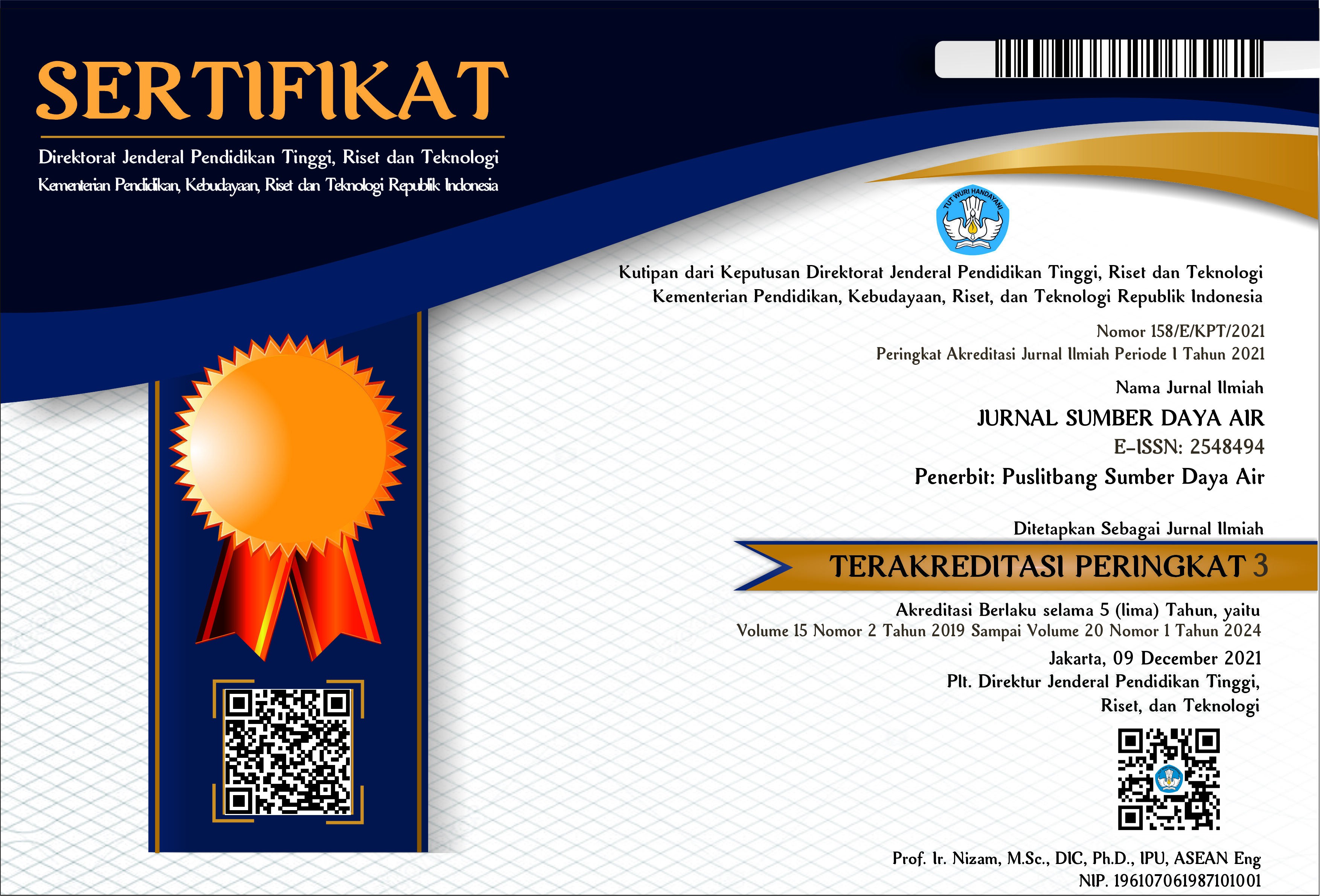Determination of hydrologic soil group for the calculation of floods At Upper Brantas Watershed
DOI:
https://doi.org/10.32679/jsda.v13i2.205Keywords:
Hydrologic Soil Group, Curve Number, Harmonized World Soil Database, water levelAbstract
Dams are planned and built to be used for water resources activities. Besides the benefits, there were a great danger if the inability of the dam structure to holding the flood is available. The choice of the right method for the magnitude of the plan flood is part of the dam security. Problems that occurred in Indonesia former record data from AWLR is not available. One method of losses flood modeling is NRCS-CN. Moreover, this method can be used for areas without flood hydrograph or reservoir water leveldata, however rainfall record data is available. In CN's determination, Indonesia does not have a HSG (Hydrologic Soil Group) map that needs to be made from another soil map like HWSD. The research was conducted using CN method using land map (HWSD), land use (BAPPEDA). Losses were carried out with HEC-HMS model. The study was conducted in the Upper Brantas basin withSutai Dam outlet. The simulation was done by calibrating the water level. HSG groups obtained from HWSD maps in Upper Brantas basin are A (loamy sand), B (loam), and D (clay). Determination of HSG from HWSD soil map with NRCS-CN loss method and NRCS UH resulted the best calibration of AMC II and λ = 0.2 in March 2007 (RMSE = 0,55) and AMC II and λ = 0.05 December 2007 (RMSE = 0.65).References
Adidarma, W. K. 2013. Teknik Perhitungan Banjir Desain untuk Bendungan Menggunakan Metode NRCS. Jurnal Teknik Hidraulik November 2013, Balai Hidrologi dan Tata Air Puslitbang SDA.
Adidarma, W. K., dan Tim. 2017. Review Hidrologi Bendungan Sutami dan Lahor. Malang: Perusahaan Umum Jasa Tirta I.
Desmukh, D. S., U. C. Chaube, A. E. Hailu, D. A. Gudeta, M. T. Kassa. 2013. Estimation and comparision of curve numbers based on dynamic land use land cover change, observed rainfall-runoff data and land slope. Journal of Hydrology 492 (2013) 89–101.
FAO/IIASA/ISRIC/ISS-CAS/JRC, 2009.Harmonized World Soil Database (version 1.1).FAO, Rome, Italy and IIASA, Laxenburg, Austria.
Halik, Gusfan, N. Anwar, B. Santosa, Edijatno. 2013. Model Ketersediaan Air di Waduk Sutami Akibat Perubahan Iklim (052a). Konferensi Nasional Teknik Sipil 7 (KoNTekS 7) Universitas Sebelas Maret (UNS) - Surakarta, 24-26 Oktober 2013.
Mishra, S. K., S. Gajbhiye, A. Pandey. 2013. Estimation of design runoff curve numbers for Narmada watersheds (India). Department of Water Resource Development & Management, IIT Roorkee, Roorkee 247 667, India.
Mishra, S. K., V. P. Singh. 2003. Soil Conservation Service Curve Number (SCS-CN) Methodology. Springer Science+Business Media Dordrecht [DOI 10.1007/978-94-017-0147-1]
Natural Resources Conservation Service. 2009. National Engineering Handbook, Chapter 7,Hydrologic Soil Group. National Engineering Handbook. Engineering Division, US Department of Agriculture, Washington, DC.
Pratama, S. Y. 2010. Studi Optimasi Operasional Waduk Sengguruh untuk Pembangkit Listrik Tenaga Air. Surabaya: Institut Teknologi Sepuluh Nopember.
Shadeed, S., M. Almasri. 2010. Application of GIS-based SCS-CN method in West Bank catchments, Palestine. Water Science and Engineering, 2010, 3(1): 1-13[doi:10.3882/j.issn.1674-2370.2010.01.001].
Soil Conservation Service, United States Department of Agriculture (SCS-USDA). 1986. Urban Hydrology for Small Watersheds. Washington, D. C.: U. S. Government Printing Office.
Triatmodjo, B. 2008. Hidrologi Terapan. Yogyakarta: Beta Offset Yogyakarta.
Windianita, K., W. K., Adidarma, D. Ardianto, Djuharijono, T. Winari. 2017. Pemodelan Banjir Waduk Sutami Menggunakan HEC-HMS. Pertemuan Ilmiah Tahunan PIT XXXIV HATHI – Jayapura Papua, 8- 10 September 2017.
Woodward, Donald E., Richard H. Hawkins, Ruiyun Jiang, Allen T. Hjelmfelt,Jr., Joseph A.Van Mullen, Quan D. Quan. 2001.Runoff Curve Number Method: Examination of The Initial Abstraction Ratio.USDA, Natural Resources Conservation Services, Tucson AZ.
Downloads
Published
How to Cite
Issue
Section
License
The Authors submitting a manuscript do so on the understanding that if accepted for publication, copyright of the article shall be assigned to Jurnal Sumber Daya Air and Pusat Penelitian dan Pengembangan Sumber Daya Air as publisher of the journal.Copyright encompasses exclusive rights to reproduce and deliver the article in all form and media, including reprints, photographs, microfilms and any other similar reproductions, as well as translations. The reproduction of any part of this journal, its storage in databases and its transmission by any form or media, such as electronic, electrostatic and mechanical copies, photocopies, recordings, magnetic media, etc. , will be allowed only with a written permission from Jurnal Sumber Daya Air and Pusat Penelitian dan Pengembangan Sumber Daya Air.
Jurnal Sumber Daya Air and Pusat Penelitian dan Pengembangan Sumber Daya Air, the Editors and the Advisory International Editorial Board make every effort to ensure that no wrong or misleading data, opinions or statements be published in the journal.




















